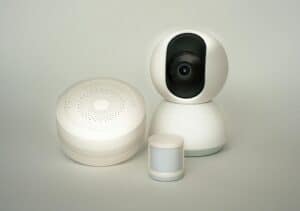Key Takeaways
- Smart alarm monitoring offers rapid response, prioritizing real-time protection for both homes and businesses.
- Technology advancements enable seamless remote oversight, automation, and easy integration with other systems.
- Personalized and scalable solutions are driving the adoption of advanced alarm monitoring across diverse property types.
- Staying informed about evolving security trends can help ensure ongoing protection and adaptability.
What Is Smart Alarm Monitoring?
Smart alarm monitoring is redefining the standard for building security in an era where instant awareness is expected and technology is always just a tap away, unlike legacy alarm systems that triggered loud sirens or sent basic signals to a control panel. Smart monitoring leverages advanced sensors, cloud platforms, and real-time data analytics to provide enhanced insights. This approach enables instant notifications, adaptive threat detection, and even remote intervention from a smartphone or computer, empowering users in ways previously not possible. Whether you’re at home, at work, or traveling halfway across the world, modern smart alarm solutions give you greater control and confidence. The addition of a reliable alarm monitoring service ensures that not only are threats detected seamlessly, but professional responders can take immediate action on your behalf, further elevating safety.
What sets smart systems apart is their ability to combine various devices—like door/window sensors, motion detectors, high-definition cameras, and AI-powered analytics—into a cohesive safety network. This interconnected ecosystem doesn’t just send alerts when something goes wrong. It can help differentiate harmless activity from genuine threats and reduce false alarms through intelligent learning. By harnessing smartphone apps, cloud dashboards, and automated routines, everyday building management has become much more proactive, minimizing blind spots that traditional systems might leave open. With these advancements, the concept of remote security is shifting from a luxury to an essential component of protection strategies for many property owners.
Advantages of Smart Alarm Monitoring for Homes and Businesses
The benefits of adopting smart alarm monitoring extend well beyond simple property protection. The most significant advantage is the near-instant detection and escalation of emergencies—whether it’s a break-in, fire, gas leak, or even a medical situation. With conventional alarms, it could take several precious minutes for a neighbor or passerby to notice a problem and contact emergency services. In contrast, monitored smart alarms are overseen by professional teams 24/7, ensuring a rapid and decisive response, no matter the time of day.
Studies indicate that homes and businesses with monitored security systems can experience a decrease of up to 60% in burglary rates. Insurance firms often offer discounts to customers who have certified alarm monitoring, recognizing the reduced financial risk associated with it. Smart alarm systems also reduce the frustrations and costs associated with false alarms, thanks to AI-powered analytics and live video verification. These features help ensure that only legitimate emergencies trigger responses, saving property owners from unnecessary stress and potential fines. For business owners, customized notifications and comprehensive event logs enable managers to monitor workflow and security simultaneously, without needing to be physically present.
Key Features to Look For
Selecting an alarm monitoring solution involves weighing a range of features tailored to your specific environment and needs. High-quality systems always offer uninterrupted 24/7 professional surveillance, but there are additional must-have capabilities modern property owners should consider.
- Immediate, multi-channel alerts: The best services notify users by phone, text, push notification, and email to maximize awareness.
- Comprehensive sensor integration: Door, window, glass-break, smoke, and motion detectors are all connected for layered protection.
- Video verification: Cameras feed live and recorded video to your phone or monitoring center, reducing ambiguity in urgent situations.
- Cloud storage: Security footage is automatically backed up and retrievable from anywhere, making it vital for investigations after an incident.
- Two-way audio: Speak directly through cameras or intercoms to warn off criminals or communicate with emergency personnel.
With these features in play, property owners can respond quickly, deter threats on the spot, and easily provide evidence when required. The flexibility to manage the system remotely is a game-changer for peace of mind.
Integration with Smart Devices
One of the most exciting parts of the rise in smart alarm monitoring is its ability to synchronize with smart home and business devices. Alarms are now commonly linked to smart locks, lighting systems, thermostats, and even sprinkler controls, adding both convenience and enhanced security. For instance, arming your alarm at night could trigger all exterior doors to lock, turn on porch lights, and enable indoor cameras—creating a holistic, seamless response.
This integration enables users to run routines such as automated bedtime security sweeps, receive verbal reminders about open windows from their virtual assistant, or check live feeds through a smartwatch or wall panel. Whether working long hours or traveling, property owners know that smart technology works together for their benefit and adapts to changes in lifestyle or risk. Even those who are less comfortable with new tech find the user interfaces increasingly intuitive.
Current Industry Trends
The landscape of alarm monitoring continues to shift rapidly as cloud and AI technologies mature. According to analyses from security industry publications, there’s strong growth in cloud-managed security platforms. These solutions lower the cost of ownership and make complex configurations accessible to even small businesses and first-time users. AI analytics now help filter out everyday activity while correctly identifying suspicious behavior, leading to fewer false alarms and greater overall accuracy.
As detailed in an overview of smart home trends, privacy and data security are taking center stage. Providers are continually refining how user data is handled, implementing robust encryption and transparency standards. Simultaneously, user-friendly apps, streamlined device interactions, and integrated emergency protocols are expected to become standard. Monitors and users alike are paying greater attention to futureproofing their systems as threats and technologies evolve.
Considerations for Choosing a Service
The cutting-edge features and integrations now available make choosing a service provider more nuanced than ever. Factors like upfront equipment costs, ongoing monitoring fees, and the ability to easily scale or modify your setup are key. Savvy shoppers also check the quality of mobile apps and user testimonials to gauge service reliability and ease of use.
- Ask about the procedure if a false alarm is triggered or if power/internet connectivity is lost.
- Check that the provider offers upgrades and supports the latest technologies as needs evolve.
- Look for certifications from independent industry organizations, like UL-Listed or Five Diamond Accreditation—it’s a strong signal of service quality.
- Ensure customer service is accessible and responsive, with clear channels for support or troubleshooting.
Businesses, especially those responsible for sensitive records or high-value goods, should pay extra attention to backup and failover protocols, while homeowners may value the simplicity of one-button controls. Finding the right balance of features and service is central to peace of mind.
Staying Informed on Security Innovations
Security technology is far from static; it is an ever-evolving landscape. As new regulations emerge and technological advancements take place at a rapid pace, it becomes increasingly essential for anyone relying on alarm monitoring systems to stay well-informed. Being proactive in this regard is not merely a suggestion; it is a wise and necessary strategy. Subscribing to newsletters from reputable security associations, regularly engaging with trusted news sites that focus on security updates, and actively participating in webinars or local workshops can significantly enhance your understanding and preparedness in this domain. Such efforts can make a significant difference not only in your readiness but also in the overall performance of your security systems.
Moreover, taking the initiative to schedule periodic reviews of system settings is crucial. It includes not only updating your contact lists for emergency notifications but also routinely checking for any firmware or app updates that could improve functionality and security. By doing so, property owners are actively contributing to the safety of their properties and the individuals within them at all times. It is equally vital for responsible property owners to remain vigilant about potential recalls, patches, or new feature releases that could address emerging vulnerabilities in their systems.
In the current digital age, being proactive in embracing smart alarm technology can greatly enhance security measures. It entails not only investing in the latest devices but also ensuring that your knowledge of industry developments is current. Such diligence makes the initial investment truly secure and future-proof, to adapt to changes and challenges that may arise in the evolving landscape of security technology. With these practices, property owners can foster an environment of safety and peace of mind, knowing they are well-prepared to face any potential threats.



